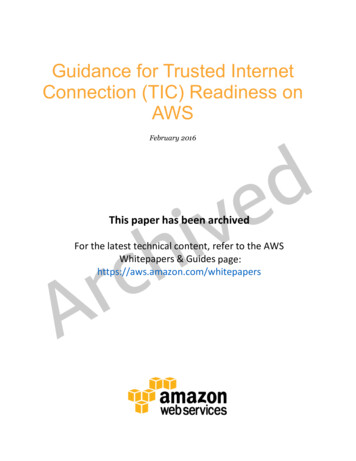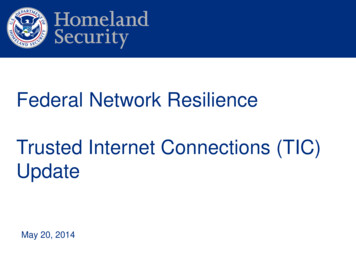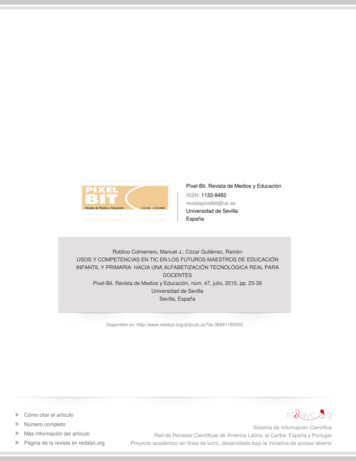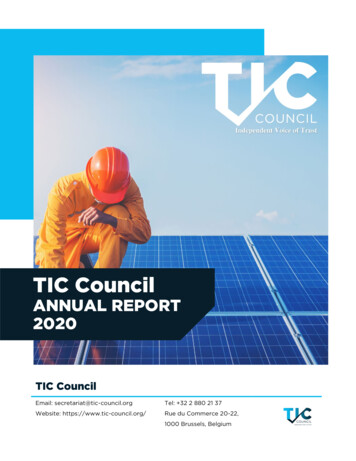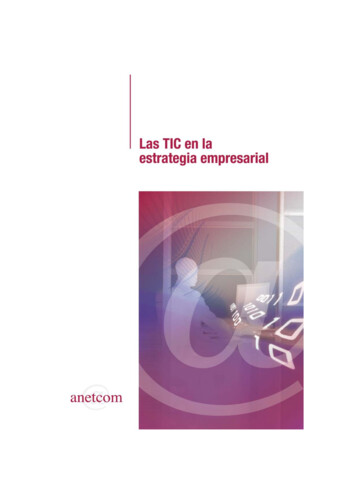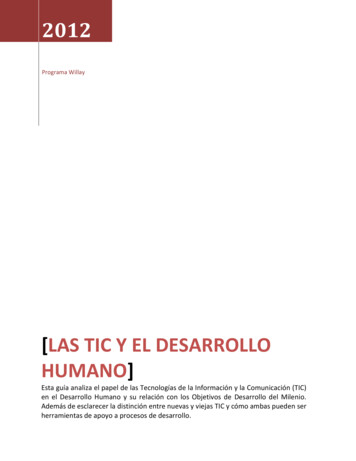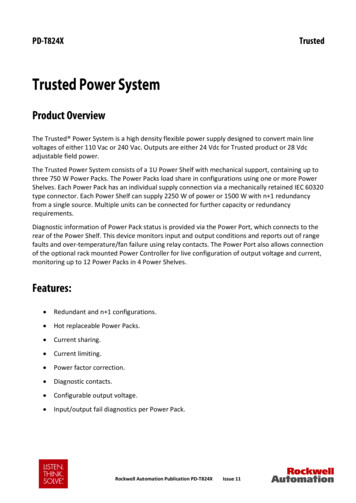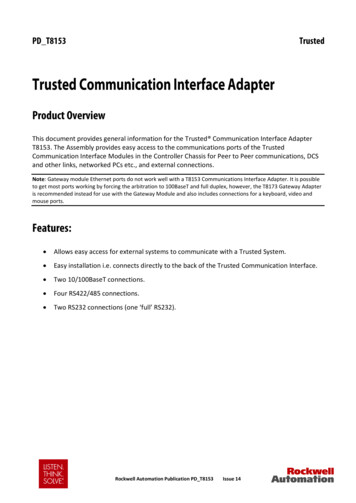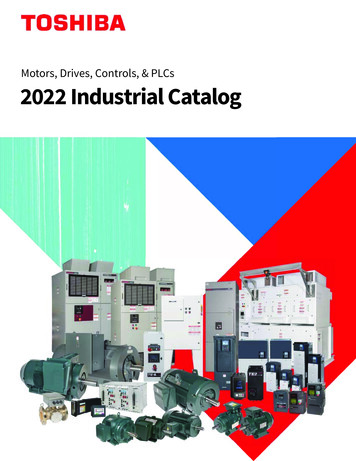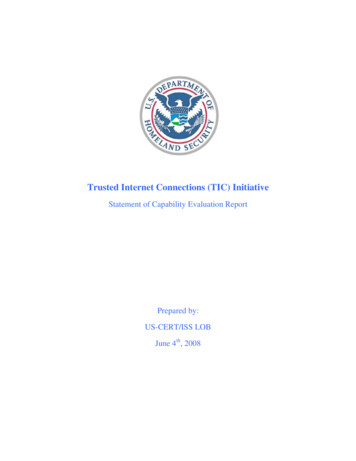
Transcription
Trusted Internet Connections (TIC) InitiativeStatement of Capability Evaluation ReportPrepared by:US-CERT/ISS LOBJune 4th, 2008
ACKNOWLEDGEMENTS. IIIRequirements Gathering Team Members. iiiStatement of Capability Evaluation Team Members. ivKey Stakeholders. ivAdvisors . ivEXECUTIVE SUMMARY . 2BACKGROUND . 3TIC Initiative .3Statement of Capability Form .4Statement of Capability Submission Data.5FINDINGS & RECOMMENDATIONS . 7Findings .7Summary Recommendations.8APPENDIX A – DEFINITION OF ACRONYMS . 9APPENDIX B – CONCEPTUAL TIC ARCHITECTURE DIAGRAM. 10APPENDIX C – AGENCIES SEEKING SERVICE . 11Page ii
ACKNOWLEDGEMENTSThis document is a summary of the activities for the Trusted Internet Connections (TIC)Initiative from December 2007 through June 2008 that includes the development of technical andbusiness model capabilities required for all TIC Access Providers and culminates with theevaluations of agency Statement of Capability proposals for how each intends to achieve therequirements of the TIC Initiative. A multitude of agencies have provided resources to assistwith a successful implementation of the TIC Initiative and made information systems security apriority in their strategic plans.Requirements Gathering Team MembersNameCecil AveryAnthony BaileyGerry BarsczewskiDon BenackPaul BlahuschCarlos BlazquezJohn BourdonGeorge CartronBobby CatesChris ChronigerDan CrossonDon CuffeeRoman DanyliwJohnny DavisJohn DiLunaSteve DiMuzioTom DonahueWalter DoveEverett DowdAdam DoyleAdam DrzalLee DudekDavid ElliottJohn FeldmanBill FlowersDoug FryBill GillDon HagerlingWalton HareTim HurrRobert HyersTodd JohnsonBen OSUSAIDGSANASADOLUSDACSOSAUS-CERTEPAISS LoB PMOISS LoB PMOCIAEPADOTGSAOPICDOIDOEd - Student AidDOSUSDAAFCAEPADHSDOSDOCIRS - CSIRCTREASURYDNINameKshemendra PaulBill LaknerThomas LeachJessica LeeJim McAuleyMarion MeissnerStu MitchellAlex MolinaZachary MurraySara Nasseh-MosleyFrederick ReyesMike SauerJessica Shih-Ning LeeRuchika SindhiMike SmithJason TamBradley TeshTroy ThompsonGail TryonEl-Farouk UmarMichael Van DykeDan VanBelleghamLinda VanKurenRandy VickersJames WarrenRichard WestfieldKenneth WhiteEric WongSteve WrightAndrew ZinnKevin WaltonBobby SinghAgency/OrganizationOMBDOLSmall Agency CouncilDOEDOLNASADOI IOSITI LoB PMODNIDOSDOEd - Student AidISS LoB PMODOEISS LoB PMODHS ISS LoB PMODOLSmithsonian InstituteSBADNIPeace CorpsDOC - CensusDOSISS LoB PMODHS/US-CERTDOISmall Agency CouncilNASAITI LoB PMODOLDNIDOIDOIPage iii
Statement of Capability Evaluation Team MembersBusiness Model Review Team supported by SRA/Touchstone Consulting GroupTechnical Review Team supported by MITRE CorporationKey StakeholdersOMB, Office of E-Government and Information TechnologyFederal CIO CouncilFederal Small Agency CIO CouncilDHS National Cyber Security Division (NCSD)Federal Systems Security Governance Board (FSSGB)Information Systems Security Line of Business (ISS LoB) - DHSDHS United States Computer Emergency Readiness Team (US-CERT)Information Technology Infrastructure Line of Business (ITI LoB) - GSAAll Federal AgenciesAdvisorsGeorge Colt, Independent Network ArchitectGary Davis, Independent Network ArchitectDavid Wennergren, Deputy CIO, DoDAlan Paller, Director of Research, SANS InstituteScott Bradner, Technology Security Officer, Harvard UniversityJames Williams, Commissioner Federal Acquisition Service (FAS), GSAPage iv
EXECUTIVE SUMMARYIn November 2007, the White House Office of Management and Budget (OMB) announced the TrustedInternet Connections (TIC) Initiative via Memorandum M-08-05 – Implementation of Trusted InternetConnections. The overall purpose of the TIC Initiative asCURRENT AND TARGET CONNECTIONSoutlined in the memorandum is to optimize and standardizeindividual external network connections, to include connections(AGENCY REPORTED)to the internet, currently in use by the federal government. Existing Connections (Jan 2008) 4300 Ultimately the initiative will improve the federal government’s Existing Connections (May 2008) 2758security posture and incident response capability through the Target Connections 100reduction and consolidation of external internet connections andprovide centralized gateway monitoring at a select group of TICAccess Providers (TICAPs).TICAPs will be modeled similarly to existing government-hosted Shared Service Centers that arecurrently operating within Lines of Business (LoBs). The technical, physical security, business model,and service level requirements were developed by an interagency workgroup, reviewed by the CIOCouncil, and approved by OMB. These requirements were integrated into a Statement of Capability(SOC) Form which provided agencies with the opportunity to propose their existing or planned capabilityto function as a TICAP and their preference to serve as a TICAP only to themselves (Single ServiceTICAP), other agencies through a shared services model (Multi-Agency TICAP), or seek services from anapproved TICAP (Seeking Services). In total, 35% of solicited federal agencies submitted a Statement ofCapability (92% of scorecard agencies). These SOCs were evaluated to determine whether or notagencies sufficiently addressed the technical and business model capabilities; the evaluation resultsdetermined that an agency either: a) met the required TICTIC ACCESS PROVIDERS (TICAPS)capabilities, b) met 90% or more of the capabilities and have aplan to address the gaps, or c) met less than 90% of the 2 Multi-Agency Service Providers with 7capabilities and plans to address the gaps need to be morepotential TICscomprehensive. All agencies not specifically designated as 16 Single Service Providers with 72Single Service or Multi-Agency TICAPs are directed to seekpotential TICsservices from another TICAP. NETWORX Providers with approximately10 potential TICsMulti-Agency TICAPs: Two agencies were determined to becapable Multi-Agency TICAPs or have aggressive plans toimplement TIC requirements within the next six months. These two Multi-Agency TICAPs representseven potential TICs. One of these agencies has demonstrated a current ability to meet the technical andbusiness capabilities required of a Multi-Service TICAP. One additional agency is conditionallyrecommended as Multi-Service TICAPs. This agency has existing gaps regarding the technical andbusiness capabilities required of a Multi-Service TICAP, but have indicated plans to address the identifiedgaps.Single Service TICAPs: 16 agencies were identified as capable Single Service TICAPs. These agencieshave demonstrated a current ability to meet the technical capabilities required of a Single Service TICAPor have sufficiently addressed gaps in their implementation plans. These 16 Single Service TICAPsrepresent 72 potential TICs. Five additional agencies met less than 90% of the capabilities and requiredmore comprehensive implementation plans.Seeking Service: The remaining 121 agencies shall seek service from an approved TICAP. Agencies thatdid not submit a Statement of Capability were also categorized as seeking service.2
BACKGROUNDTIC InitiativeThe Trusted Internet Connections (TIC) Initiative commenced in November 2007 with theissuance of Office of Management and Budget (OMB) Memorandum M-08-05 – Implementationof Trusted Internet Connections to optimize each individual federal agency’s network servicesinto a common solution for the federal enterprise and establish guidelines for agencies to providea plan of action and milestones (POA&Ms) for meeting TIC deadlines. The purpose of thePOA&Ms was to document the agency’s existing connections as of January 2008 and provideplans to reduce and consolidate those connections. Additionally, with the release of OMBMemorandum M-08-16 – Guidance for Trusted Internet Connection Statement of CapabilityForm (SOC) on April 4, 2008, agencies were requested to propose their solution and outline theirlevel of capability to become a Single or Multi-Agency TIC Access Provider (TICAP). On May1, 2008, agencies also provided a business justification that outlines the number of TICs that arenecessary in order to support their current mission requirements and customer base.Between the two referenced guidance memorandums, milestones have been outlined that helpdefine the current state of external connections within the federal enterprise as well as articulatethe actions to achieve the objectives of the TIC Initiative. Specifically, the milestones arehighlighted in Figure 1 below.Figure 1: TIC Initiative Timeline3
The overall approach is being executed in three concurrent phases:Phase I: Agency Plan for Reduction and Consolidation of External Connections: InJanuary 2008, agencies submitted POA&Ms that inventoried their existing number ofexternal connections and outlined a plan to optimize their existing connections. Agencieswere required to update this plan on April 15, 2008.Phase II: TICAP Initial Capability: In February, 2008, OMB and DHS led aninteragency workgroup to define the technical capabilities required of a Trusted InternetConnection and the business model capabilities for TIC Access Providers. Oncecompleted, the requirements were vetted through all agency CIOs; their feedback wasconsidered and incorporated into the final requirements document.The primary focus is on approving Single Service TICAPs, scorecard agencies servingtheir internal customer base, and Multi-Agency TICAPs, scorecard agencies serving otheragencies as external customers that sufficiently meet the technical and business modelcapabilities published in the Statement of Capabilities Form. Work is being done withGSA to provide agencies with a TIC-compliant managed security solution through theNETWORX contract vehicle so that several NETWORX TICAPs will also be designated.It is envisioned that a majority of agencies will utilize NETWORX as a source of TICAPservices both as a managed solution or implemented as part of an agency’s Single ServiceTICAP solution. DHS is also developing an independent compliance capability modeledafter the DoD’s Computer Network Defense Service Provider (CNDSP) that will bechartered to ensure initial and ongoing compliance with the TIC Initiative.Phase III: TICAP Mature Capability: Single Service TICAPS will continue to maturetheir technical and business processes in providing service to their internal customers. Asboth Multi-Agency and NETWORX TICAPS become available, agencies who haveselected that they intend to Seek Service will be expected to transition to one of theapproved TICAPs under an aggressive timeline.Statement of Capability FormThe requirements that define a TIC and the selection criteria for becoming a TICAP weredefined in February 2008 by an interagency work group comprised of approximately 30 federalcivilian agencies. The technical requirements were categorized as “Critical”, “Important”, or“Desired”; at a minimum, every TICAP must comply with the “Critical” requirements and mayalso choose to incorporate other elements of the “Important” and “Desired” requirements toenhance their solution. The draft requirements were reviewed by OMB and distributed to agencyCIOs for final feedback and approval; this feedback was incorporated and agencies weresolicited to propose their solution. The SOC Form provides agencies the opportunity todemonstrate their existing and future capability to meet technical and business capabilities thatdefine a TICAP. Submitted Statements of Capability were evaluated and the results are providedin this report for input and feedback from the Federal Systems Security Governance Board(FSSGB), the CIO Council, and OMB.4
The Statement of Capability Form requested information on how an agency planned to provideservices as a TICAP whether to service their internal customer base or external customers fromother agencies. Alternatively, Agencies could indicate whether they intended to fulfill the TICrequirements by seeking service from an authorized TICAP. The SOC Form was comprised ofthree sections: Business Model Capabilities, Technical Capabilities; and Seeking ServiceExplanation. Agencies were asked to fill out specific portions of the form depending on theirrequested TICAP type.Statement of Capability Submission DataFigure 2: Self-Selected TICAP Types1Seeking Service Submissions82%Single-Service Submissions15%Multi-Service Submissions3%Statement of Capability Form Review ProcessCommencing on April 15, 2008 the Statement of Capability submissions have undergone a threestaged evaluation process to ensure that all information required by M-08-16 was provided. Asoutlined in Figure 3, Agencies were engaged in a continuous feedback cycle throughout Stage Iand Stage II to address questions as they arose.The evaluation team followed an approved evaluation plan outlining a transparent process thatoffered a repeatable and consistently-scored assessment of an agency’s capability to sustain theoperations of a TICAP. The Plan is divided into three stages, each with a specific purpose andfocus: STAGE I – Quality Assurance: The initial process was focused on document control,inventory of required information, and compliance with M-08-16. Evaluators loggedsubmitted Statement of Capability Forms and supporting documentation then performedan initial check of the information to assure that it responded to all necessary elementswith appropriate information. Submissions requiring additional or amplifyinginformation were returned to the agency for update and follow-up meetings with theagencies were conducted to ensure clear communication for all stakeholders. STAGE II – Technical and Business Model Review: Two independent teams focusedon individual aspects of the SOC; a technically-oriented team evaluated the technical1Data presented is based upon 144 Agencies that were provided an opportunity to submit a Statement of Capability.The data in the chart was derived from submitted agency Statement of Capability forms.5
capabilities while a separate team evaluated the agency’s response to the business modelcapabilities. STAGE III – Consensus Review: Representatives from both Stage II evaluation teamsworked together to take a holistic approach in reviewing both the technical and businessmodel capabilities to determine which agencies adequately demonstrated a capability todeliver TICAP services consistent with their self-identified TICAP selection.Figure 3: Statement of Capability Evaluation Process6
FINDINGS & RECOMMENDATIONSFindingsA) One agency has demonstrated an immediate ability to meet 100% of the critical technicalcapabilities for becoming a Multi-Service TICAP. This Multi-Agency TICAP represents twopotential TICs.B) One agency has demonstrated an ability to meet at least 90% of the TIC capabilities forbecoming a Multi-Service TICAP and has demonstrated aggressive plans to meet thetechnical requirements. This Multi-Agency TICAP represent five potential TICs.C) 16 agencies have demonstrated an ability to meet at least 90% of the TIC capabilities forbecoming a Single Service provider. These agencies have planned actions to address anyidentified gaps. These sixteen Single Service TICAPs represent 72 potential TICs.D) Five agencies have not met at least 90% of the technical requirements or have notsufficiently indicated plans to meet the requirements to address identified gaps.E) 121 agencies have indicated a preference to seek service from an approved TICAP or didnot submit a Statement of Capability form.F) The total number of TICs target connections identified by agencies outlined in FindingsA, B, C, and D2 is 79.G) Agencies have indicated a significant reduction and consolidation of existing externalconnections from more than 4,300 in January 2008 to 2,758 (39%) as of May 2008.H) The evaluation team noted a difference between the number of agency-reported targetconnections (235) and the calculated number of target connections (79). Additionaleffort will be required to reconcile this difference.I) Based on SOC submittal information and evaluations, additional coordination withagencies will be needed regarding implementation of technical requirements such as:deep packet inspection of encrypted sessions, storage volume requirements, uniform timeservices, the sharing and use of custom IDS signatures, and Sensitive CompartmentalizedInformation Facility (SCIF) requirements.J) NETWORX will provide flexibility to those agencies that do not currently have thecapability to function in a Single-Service or Multi-Service capacity. Most agenciesindicated an intention to incorporate NETWORX managed security capabilities as part oftheir TIC implementation.2One agency in this grouping has engaged in ongoing efforts to project their target number of target connections.Additional dialogue will be required and will likely increase the number of overall target connections.7
K) Prospective Multi-Service provider responses concerning business capabilities focusedprimarily on IT security risks and did not address other technical, financial, or operationalrisks.Summary RecommendationsA) Designate two agencies as Multi-Service TICAPs; all must demonstrate an ability to meet100% of the technical requirements to a CNDSP audit team prior to being authorized toaccept external customers.B) Designate 16 Agencies as Single-Service TICAPs; all must demonstrate an ability tomeet 100% of the technical requirements to a CNDSP audit team prior to acknowledginga mature operating capability.C) Agencies that did not sufficiently meet the requirements must resubmit a statement ofcapability to the ISS LoB by August 01, 2008 that demonstrates plans to meet 100% ofthe technical requirements for becoming a Single Service TICAP within 3 months orconsider seeking service from an approved TICAP.D) Schedule follow-up meetings to address existing gaps with the 17 (16 Single Service and1 Multi-Service TICAPs) agencies that have demonstrated an ability to meet at least 90%of the TIC capabilities for becoming a Single or Multi-Service provider.E) The total number of TICs that should be allocated is less than 100 (79 target connectionsidentified by agencies and approximately 10 TIC locations for future use by NETWORXTICAPs).F) Schedule meetings to discuss federal enterprise level considerations to include: networktopology, bandwidth, fault tolerance, baseline audit compliance, EINSTEIN deployment,and to address international TIC locations.G) Schedule meetings with agencies to finalize TIC locations and reconcile differencesbetween the number of agency-reported target connections and calculated number oftarget connections.H) Establish a government-wide TICAP program plan to include implementation andCONOPS. The plan should be coordinated with DHS and agency CIOs.I) Establish a cross-agency coordinating group to provide practical feedback into thegovernment-wide TIC implementation plan.J) Modify the existing ISS LoB FSSGB charter to include TIC governance and oversight.K) Explore overall impact of TIC on state, municipal and local governments.L) Provide TICAPs and customer agencies with guidelines to assist in transition planning.8
Appendix A – Definition of AcronymsAcronymCNDSPDHSFSSGBISS LoBITI LoBOMBPOA&MSOCTICTICAPDefinitionComputer Network Defense Service ProviderDepartment of Homeland SecurityFederal Systems Security Governance BoardInformation Systems Security Line of BusinessInformation Technology Infrastructure Line of BusinessOffice of Management and BudgetPlan of Action and MilestonesStatement of CapabilityTrusted Internet ConnectionsTrusted Internet Connections Access Provider9
Appendix B – Conceptual TIC Architecture Diagram10
Appendix C – Agencies Seeking Service33This is not an exhaustive list and will be continually updated.11
with a successful implementation of the TIC Initiative and made information systems security a priority in their strategic plans. Requirements Gathering Team Members . GSA to provide agencies with a TIC-compliant managed security solution through the NETWORX contract vehicle so that several NETWORX TICAPs will also be designated.
